How the COVID-19 pandemic affected the EfficienCE partners?
March 2020 – May 2020
The global pandemic affected both our project and our cities’ transport system. Like in many places in the world, people lost their trust in the public transport and were advised against its usage (for the passengers’ own health safety). Therefore, the number of passengers has dramatically dropped. Here is a short overview how our partner cities dealt with the lockdown.
The public transport operations were completely stopped only in Maribor.

Public transport in Maribor after it opened again (11 May)
The other cities introduced quite similar measures, adapted to the local circumstances. Since the utilization of the public transport was at 10-30 percent of the normal, one of the first steps was to change the frequency of the services. The introduction of new timetables was not an easy task: the supply had to meet the current demand which required constant monitoring while keeping the number of passengers per vehicle low to maintain the sufficient distance between them. In Pilsen, the frequency of the public transport was reduced to 80 percent of the normal performance, while Vienna introduced the Saturday schedule except for certain lines where the frequency is higher during rush hours. In Gdynia, the number of passengers was limited to 30% of the whole capacity.
To secure the drivers’ safety, in most cities they cancelled first-door boarding and the driver’s area was closed from passengers. Buying tickets was not possible from the driver. Wearing masks on the public transport was not mandatory everywhere from the beginning (in most cities it was only mandatory from mid-April or May). And finally, the disinfection of the vehicles is done with different methods, but the goal is everywhere the same: to keep passengers safe. For example, in Pilsen they use nanotechnology which has a longer effect than conventional methods.

- Public transport in Gdynia during COVID-19 (photo: PKT)
With the gradual lifting of restrictions in all spheres of life – although with different pace – things are getting back to normal. However, there are two big challenges for public transport companies: firstly, how to recover the financial loss and secondly, how to win back the society’s trust.
Background photo: Budapest transport (by Mobilissimus)
